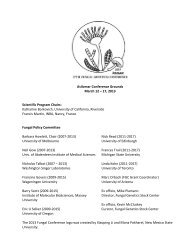Asperfest 4 Program - Fungal Genetics Stock Center
Asperfest 4 Program - Fungal Genetics Stock Center
Asperfest 4 Program - Fungal Genetics Stock Center
You also want an ePaper? Increase the reach of your titles
YUMPU automatically turns print PDFs into web optimized ePapers that Google loves.
1,7 2<br />
34. Comparative and functional genomics in identifying aflatoxin biosynthetic genes. Jiujiang Yu , Jeffery Wilkinson , Gary<br />
3 4 5 6 1 1 7,8<br />
Payne , Masayuki Machida , Bruce Campbell , Joan Bennett , Deepak Bhatnagar , Thomas Cleveland , and William Nierman .<br />
1 2<br />
USDA/ARS, Southern Regional Research <strong>Center</strong>, New Orleans, LA 70124, USA; Mississippi State University, Mississippi State,<br />
3 4<br />
MS 39762, USA; North Carolina State University, Raleigh, NC 27695, USA; National Institute of Advanced Industrial Science and<br />
5 6<br />
Technologies (AIST), Tsukuba, Ibaraki, Japan; USDA/ARS, Western Regional Research <strong>Center</strong>, Albany, CA 94710, USA; Rutgers<br />
7 8<br />
University, New Brunswick, NJ 08901, USA; The Institute for Genomic Research, Rockville, MD 20850, USA; The George<br />
Washington University School of Medicine, Washington, DC 20037, USA<br />
Identification of genes involved in aflatoxin biosynthesis through Aspergillus flavus genomics has been actively pursued. A. flavus<br />
Expressed Sequence Tags (EST) and whole genome sequencing have been completed. Groups of genes that are potentially involved<br />
in aflatoxin production have been profiled using microarrays under different culture conditions and during fungal infection of corn.<br />
Preliminary annotation of the sequence revealed that there are about 12,000 genes in the A. flavus genome. Many genes in the genome,<br />
which potentially encode for enzymes involved in secondary metabolite production, such as polyketide synthases, non-ribosomal<br />
peptide synthases, cytochrome P450 monooxigenases, have been identified. Comparative analysis of A. flavus genome with food<br />
grade industrial fermentation organism A. oryzae can help understanding the mechanism of aflatoxin biosynthesis and solving the<br />
problem of aflatoxin contamination.<br />
35. Growth and developmental control in Aspergillus nidulans and A. fumigatus. Jae-Hyung Mah and Jae-Hyuk Yu Department<br />
of Bacteriology, University of Wisconsin, Madison, WI 53706<br />
The opportunistic human pathogen Aspergillus fumigatus reproduces by forming a large number of asexual spores. We studied the<br />
mechanisms regulating asexual development in A. fumigatus via examining functions of four key controllers, GpaA (G alpha), AfFlbA<br />
(RGS), AfFluG and AfBrlA. Expression analyses of gpaA, AfflbA, AffluG, AfbrlA and AfwetA revealed that, whereas transcripts<br />
of AfflbA and AffluG accumulate constantly, AfbrlA and AfwetA are specifically expressed during conidiation. Both loss of function<br />
AfflbA and dominant activating GpaAQ204L mutations resulted in reduced conidiation coupled with increased hyphal mass,<br />
indicating that GpaA mediates signaling that activates vegetative growth while inhibiting conidiation. As GpaA is the principal target<br />
for AfFlbA, the dominant interfering GpaAG203R mutation suppressed the phenotype resulting from loss of AfflbA function. These<br />
results corroborate the idea that parimary roles of G proteins and RGSs are conserved in aspergilli. Functions of the two major<br />
developmental activators AfFluG and AfBrlA are then examined. While deletion of AfbrlA eliminated conidiation completely,<br />
deletion of AffluG did not cause severe defects in A. fumigatus sporulation in air-exposed culture, implying that, whereas the two<br />
Aspergillus species may have a common key downstream developmental activator, upstream mechanisms activating brlA may be<br />
distinct. Finally, both AffluG and AfflbA mutants showed reduced conidiation and delayed accumulation of AfbrlA mRNA in<br />
developmental induction, indicating that these upstream regulators are associated with the proper progression of conidiation.<br />
1 2 3 4<br />
36. Integrated database for functional analysis in Aspergillus flavus.C. P. Smith , C. P. Woloshuk , N. P. Keller , J. Yu , and G.<br />
51 2<br />
A. Payne North Carolina State University, Raleigh, USA. chris@statgen.ncsu.edu. Purdue University, West Lafayette, IN, USA.<br />
3 4<br />
woloshuk@purdue.edu. University of Wisconsin, Madison, WI, USA. npk@plantpath.wisc.edu. USDA/ARS/SRRC, New Orleans,<br />
5<br />
LA, USA. jiuyu@srrc.ars.usda.gov. North Carolina State University, Raleigh, USA. gary_payne@ncsu.edu.<br />
Aspergillus flavus is a plant and animal pathogen that also produces the carcinogen, aflatoxin. Because of its economic importance<br />
and well characterized pathway of aflatoxin biosynthesis, several labs are studying the development, metabolism, ecology, and<br />
pathogenicity of this fungus. To facilitate the research efforts in these areas and to identify potential genes and pathways for functional<br />
analysis, we are developing a database to integrate multiple categories of data. This database resource will serve two important<br />
functions: 1) it will provide a platform for the deposition of data from individual experiments; and 2) it will permit the ready analysis<br />
of composite data from all experiments enabling researchers to mine a larger data set. It will include phenotypic measurements, gene<br />
expression data from microarrays, and metabolic profile information and will be flexible enough to allow the addition of new types<br />
of measurement in the future. Users will interact with the database through a web based interface and will be able to: describe<br />
experiments; upload data gathered during those experiments; run analyses on the data; select and download raw data; select and<br />
download the results of analyses. Recently acquired lab and field data will be used to highlight the structure and utility of this<br />
database. These measurements will include fungal growth, aflatoxin concentrations, and gene expression data acquired from lab<br />
studies and infected developing maize seeds. This research was funded by USDA/NRI/CGP 2006-35604-16666.<br />
4th International Aspergillus Meeting 16 Poster Abstracts











